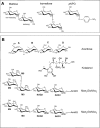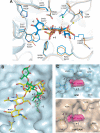Structural basis for substrate selectivity in human maltase-glucoamylase and sucrase-isomaltase N-terminal domains
- PMID: 20356844
- PMCID: PMC2878540
- DOI: 10.1074/jbc.M109.078980
Structural basis for substrate selectivity in human maltase-glucoamylase and sucrase-isomaltase N-terminal domains
Abstract
Human maltase-glucoamylase (MGAM) and sucrase-isomaltase (SI) are small intestinal enzymes that work concurrently to hydrolyze the mixture of linear alpha-1,4- and branched alpha-1,6-oligosaccharide substrates that typically make up terminal starch digestion products. MGAM and SI are each composed of duplicated catalytic domains, N- and C-terminal, which display overlapping substrate specificities. The N-terminal catalytic domain of human MGAM (ntMGAM) has a preference for short linear alpha-1,4-oligosaccharides, whereas N-terminal SI (ntSI) has a broader specificity for both alpha-1,4- and alpha-1,6-oligosaccharides. Here we present the crystal structure of the human ntSI, in apo form to 3.2 A and in complex with the inhibitor kotalanol to 2.15 A resolution. Structural comparison with the previously solved structure of ntMGAM reveals key active site differences in ntSI, including a narrow hydrophobic +1 subsite, which may account for its additional substrate specificity for alpha-1,6 substrates.
Figures



Similar articles
-
Mammalian maltase-glucoamylase and sucrase-isomaltase inhibitory effects of Artocarpus heterophyllus: An in vitro and in silico approach.Comput Biol Chem. 2024 Jun;110:108052. doi: 10.1016/j.compbiolchem.2024.108052. Epub 2024 Mar 12. Comput Biol Chem. 2024. PMID: 38492557
-
Dietary phenolic compounds selectively inhibit the individual subunits of maltase-glucoamylase and sucrase-isomaltase with the potential of modulating glucose release.J Agric Food Chem. 2015 Apr 22;63(15):3873-9. doi: 10.1021/jf505425d. Epub 2015 Apr 13. J Agric Food Chem. 2015. PMID: 25816913
-
Luminal starch substrate "brake" on maltase-glucoamylase activity is located within the glucoamylase subunit.J Nutr. 2008 Apr;138(4):685-92. doi: 10.1093/jn/138.4.685. J Nutr. 2008. PMID: 18356321
-
Naturally occurring sulfonium-ion glucosidase inhibitors and their derivatives: a promising class of potential antidiabetic agents.Acc Chem Res. 2014 Jan 21;47(1):211-25. doi: 10.1021/ar400132g. Epub 2013 Aug 22. Acc Chem Res. 2014. PMID: 23964564 Review.
-
Structural Studies of the Intestinal α-Glucosidases, Maltase-glucoamylase and Sucrase-isomaltase.J Pediatr Gastroenterol Nutr. 2018 Jun;66 Suppl 3:S11-S13. doi: 10.1097/MPG.0000000000001953. J Pediatr Gastroenterol Nutr. 2018. PMID: 29762369 Review.
Cited by
-
Targeting N-Terminal Human Maltase-Glucoamylase to Unravel Possible Inhibitors Using Molecular Docking, Molecular Dynamics Simulations, and Adaptive Steered Molecular Dynamics Simulations.Front Chem. 2021 Aug 30;9:711242. doi: 10.3389/fchem.2021.711242. eCollection 2021. Front Chem. 2021. PMID: 34527658 Free PMC article.
-
Optimization and semi-continuous fermentation of gluco-oligosaccharide production with Weissella cibaria YRK005.Food Sci Biotechnol. 2024 Sep 9;34(4):991-1000. doi: 10.1007/s10068-024-01703-z. eCollection 2025 Mar. Food Sci Biotechnol. 2024. PMID: 39974872
-
Inhibition of Intestinal α-Glucosidase and Glucose Absorption by Feruloylated Arabinoxylan Mono- and Oligosaccharides from Corn Bran and Wheat Aleurone.J Nutr Metab. 2016;2016:1932532. doi: 10.1155/2016/1932532. Epub 2016 Mar 17. J Nutr Metab. 2016. PMID: 27073693 Free PMC article.
-
Phenolics from Chrozophora oblongifolia Aerial Parts as Inhibitors of α-Glucosidases and Advanced Glycation End Products: In-Vitro Assessment, Molecular Docking and Dynamics Studies.Biology (Basel). 2022 May 17;11(5):762. doi: 10.3390/biology11050762. Biology (Basel). 2022. PMID: 35625490 Free PMC article.
-
Acute metabolic actions of the major polyphenols in chamomile: an in vitro mechanistic study on their potential to attenuate postprandial hyperglycaemia.Sci Rep. 2018 Apr 3;8(1):5471. doi: 10.1038/s41598-018-23736-1. Sci Rep. 2018. PMID: 29615674 Free PMC article.
References
-
- Van Beers E. H., Büller H. A., Grand R. J., Einerhand A. W., Dekker J. (1995) Crit. Rev. Biochem. Mol. Biol. 30, 197–262 - PubMed
-
- Semenza G. (1986) Ann. Rev. Cell Biol. 2, 255–313 - PubMed
-
- Quezada-Calvillo R., Sim L., Ao Z., Hamaker B. R., Quaroni A., Brayer G. D., Sterchi E. E., Robayo-Torres C. C., Rose D. R., Nichols B. L. (2008) J. Nutr. 138, 685–692 - PubMed
-
- Heymann H., Breitmeier D., Günther S. (1995) Biol. Chem. Hoppe Seyler 376, 249–253 - PubMed
Publication types
MeSH terms
Substances
Associated data
- Actions
- Actions
Grants and funding
LinkOut - more resources
Full Text Sources
Molecular Biology Databases

